
- Distribution of Fires
- How Big Are Alaska’s Fires?
- Fire Ecology
- Wildfire and Insect Infestations
- Fires and Weather
- Fast Burns, Cool Fires, and Ovens
- Climate Change & Fire
- How Much of Alaska Burns?
- Conclusion
- Fire Distribution
- Fire Ecology
- Size of Alaska Fires
- Insect Infestations
- Fire and Weather
- Intensity of Burning
- Acreage Burned
- Climate Change
- Conclusion
Fire is not a problem to be solved in Alaska, but a natural process to be managed. However, dramatic new fires patterns may be emerging in high latitudes, linked to climate change. Alaska’s 2007 Anaktuvuk fire was the largest tundra fire in recorded history, and Russia’s record-breaking 2010 fire season may be a forerunner to a future of more aggressive burning in the boreal forest.
Large fires burn in Alaska’s interior forest (also known as boreal forest, or taiga). Fire plays a lesser role in the tundra and throughout southern Alaska. Wildfire is almost non-existent in Southeast Alaska’s rainforests and the Alaska Peninsula. Wildfire interacts with climate, weather, wildlife, forest lifecycles, insect infestations, and other factors - including humans.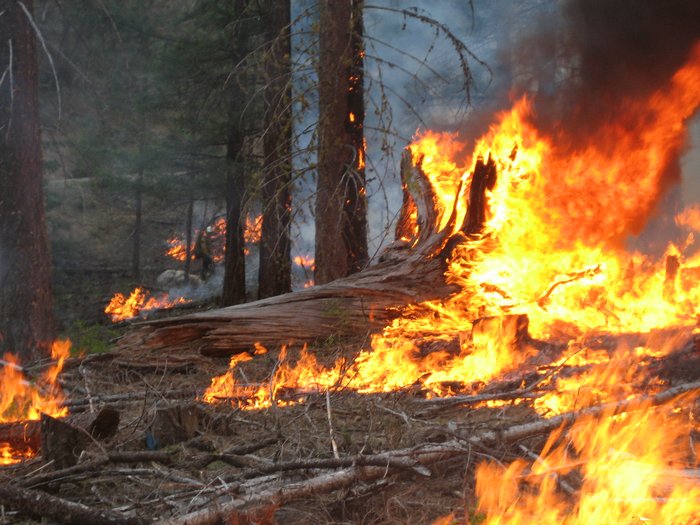
Distribution of Fires
Most of Alaska’s wildfires occur in the interior forests, north of the Alaska Range and into the Brooks Range. An excellent map of the fire Alaska historic fires, overlaid on the boreal forest biome, is on 4th page of this government report.
Fire is a normal part of the boreal forest ecosystem, which wraps around the globe through Alaska, northern Canada, northern Russia, and parts of Scandinavia. Large fires are a frequent occurrence in these vast, sparsely settled forests. The severity of a given fire season varies dramatically, based on weather and climatic oscillations: In both 2004 and 2005, roughly 5% of the boreal forest burned. In 2008, in contrast, a miniscule 0.04% of the forest burned.
Fires frequently become very large in the boreal forest due to a combination of continuous forest, sparse human settlement, light fires suppression, and dry summer weather. Suppression usually focuses on protecting isolated cabins and communities in the path of fires, rather than containing and extinguishing them. Natural barriers which limit fire spread are few, mostly comprised of muskeg, moist tundra, barren ground, rivers, lakes, and deciduous groves. Each year, fires are definitively stopped by sustained cool and rainy weather conditions, which typical arrive in mid to late summer.
In southern Alaska, wildfires are rare and typically small, although in recent years several large fires have caused public concern, including the Mile 17 fire which burned for a week near Homer. Fires insouthern Alaska are linked to unusually warm, dry summer conditions, and may find ready fuel in the large tree kills caused by spruce beetle infestations. Occasional large fires are not new to south, particularly the Kenai Peninsula: they have occurred as far back as we have consistent records. A large swath of Kenai’s inland forest burned in the 1940s.
Fires are very rare on the North Slope’s tundra, which has historically been too moist to carry sustained fire. The 2007 Anaktuvuk fire, was a dramatic exception to this, and may nonetheless be the forerunner of large tundra fires in the future, as the arctic warms.
Our knowledge of fire history in Alaska is, however, incomplete. Historic records are of limited quality, due to incomplete fire reconnaissance through much of the state’s history. Our prehistoric knowledge of fire in Alaska relies on such clues as soot layers in the soil and the study of tree rings (dendrochronology). Lightning-strike sensing and better aerial reconnaissance have helped improve the fidelity of Alaska’s fire sensing in recent history, but records are apt to be of particularly low quality in remote areas where fires self-limit and burn out quickly.
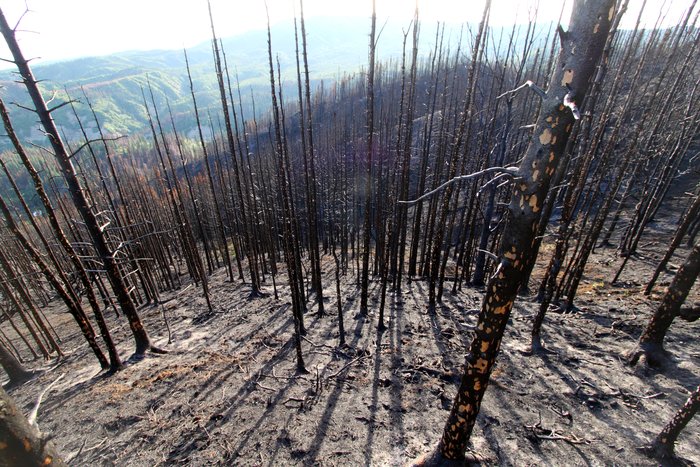
How Big Are Alaska’s Fires?
Alaska’s fires are typically bigger than those of the lower 48 states. This is a function of both the boreal forest and weak fire suppression. According to National Interagency Fire Center (NIFC) data, over the last 10 years, the average Alaska fire has consumed 3,500 acres - as opposed to a nationwide average of 100 acres.
Alaska holds the record for the largest U.S. wildfire in the last 10 years: the 1.3 million-acre Taylor Complex fire in 2004. Overall, though, Alaska has taken the crown for the largest annual U.S. wildfire only twice in the last 10 years (2004-2013). Alaska’s large fires are a product of policy, remoteness, and ecology.
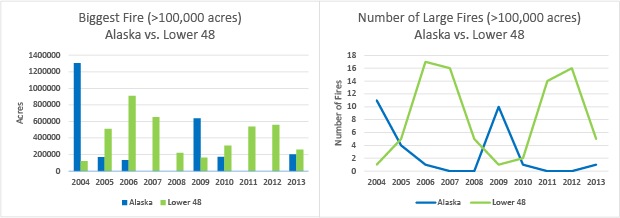
Fire Ecology
Globally, many environments have a “Fire ecology”, meaning they have evolved with (and exist in balance with) periodic wildfires. The black spruce forests of Alaska have just such a fire ecology, as do the semi-arid ponderosa pine forests of the American West, the chaparral of Southern California, and the prehistoric Great Plains.
Fires are usually self-limiting in a fire ecology. Wildfires clear out thick forest “reprod” (small, closely spaced young trees, or “reproduction”) and dead wood, leaving a sparser and park-like forestland in their wake. Many wildlife species, including moose, thrive in the resulting mosaic habitat. These mosaic forests of intermixed open areas and tree stands of different ages provide less continuous, less homogeneous fuel for wildfires than dense and homogenous stands of trees. As a result, fire does not burn as consistently through mosaic habitat. Mosaic habitat thus tends to naturally contain and moderate wildfires, which in turn helps to perpetuate the mosaic habitat. If frequent fire, animal browsing, and other forces do not maintain a mosaic habitat, the forest may mature into dense stands of trees, and dead wood may accumulate, making intense burning more likely.
In many lower-48 forests, aggressive human suppression of wildfire has created high concentrations of dead wood and overmature tree stands. This has led to more intensive burning, as exemplified by the West’s ponderosa forests. However, Alaska has largely avoided this, due to the lightness of historic Alaskan fire suppression.
Wildfire and Insect Infestations
Endemic insect infestations are often understood as part of a dynamic between forest growth, drought, fire, and other local forces that affect forest health.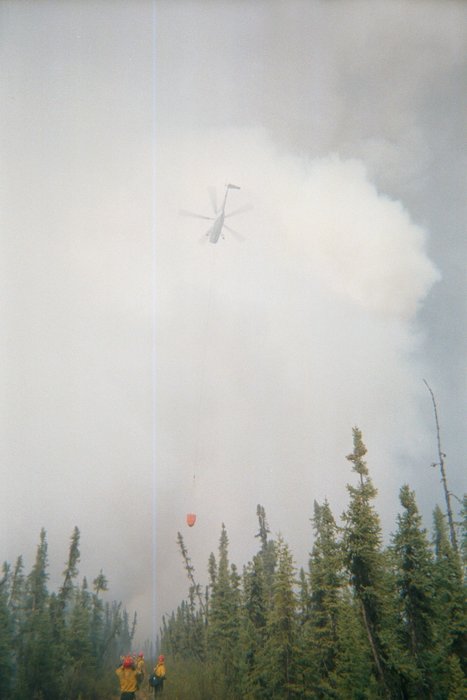
For instance, drought might render trees vulnerable, resulting in increased infestation rates and tree mortality. Wildfire then burns hotter and more aggressively with so much dead wood available, reducing timber acreage and creating younger forests while suppressing the infestations by destroying the insect larvae, their homes, and their food source. The cycle can also work in reverse: The U.S. Forest Service (USFS) has noted that spruce beetle outbreaks are often encouraged by fire and wind damage of forests. The tree-kills from the pest outbreaks then, of course, provide fuel for more wildfires.
Whether fire encourages or suppresses infestations can be a matter of the degree of fire-driven deforestation, the timeline involved, and the species of insect: Each species of pest has its own habits, needs, and preferred environmental conditions. These competing dynamics move in a dynamic equilbrium over time, creating cycles in forest rather than settling to a long-term static state. The basic dynamic is such a clear example of a natural feedback loop that it was used as an instructive example in Donella H. Meadows’ classic systems theory book, Thinking in Systems.
Human forestry practices also interact with this dynamic. For instance, humans can suppress the wildfire component of the cycle while altering forest composition by logging, and increasing the amount of “slash” (light woody fuel) on the ground, providing more habitat for pests. Introduction of invasive pests such as the birch leaf miner can further distort the forest’s dynamic, creating new patterns of die-off and altering the balance of tree species. In contrast, the spruce beetle devastating Alaska’s spruce forests is an endemic insect, meaning that it is always present in the forest. Recent conditions have allowed a population explosion, but the spruce beelte is as Alaskan as the spruce trees it infests.
Fires and Weather
Wildfire is strongly controlled by weather. A simple way to think about it is that vegetation provides the basic fuel for a fire, but weather exerts dominant control on whether the fuel is burnable. In warm, dry conditions, forest and tundra fuels become drier, making them more available for burning. This drying also creates the characteristic shift from soft, moist tundra and wetland to “crunchy” tundra and dried-out swamps. This drying-out is less apparent in black spruce trees, since their tight needles resist water loss and make dryness less visible.
On a seasonal scale, interior black spruce forests survive the cold interior winters by dropping their internal water content very low, becoming very resinous. High burning season occurs between spring melt-out and the arrival of summer rains. During this time, the forests are relatively dry, and lightning from transient thunderstorms often causes fires. Moderately high temperatures, low humidity, and winds can drive fires vigorously through the spruce forests. The spruce needles’ high resin content makes the needles combustible at relatively high water content. It is the high resin content, coupled with summer weather conditions, which makes such fast-moving crown fires of the boreal forest possible. Passing thunderstorms, while they briefly wet the trees and tundra, do not establish sufficient baseline humidity to suppress burning, and the direct sunlight which follows their passage can dry fuels quickly. Once the regular rains start, frequent rain and higher ambient humidity tends to extinguish even the largest fires.
Fast Burns, Cool Fires, and Ovens
These myriad factors - and more - combine to create the character and burning pattern of a particular fire. Fires are not uniform. The boreal forest’s large fires frequently burn hot (and move fast) in some places, but burn slow and “cool” in others.
Generally, “cool” fires burn in semidry or marginal conditions, or in hot, dry conditions with only intermittent fuel. In these conditions, the fire cannot build sufficient heat and momentum to sustain long flames and extreme temperatures. Very hot burning occurs only in heavy, dry fuel concentrations, such as masses of fallen trees. Cool fires typically create mosaic burns, leave many trees alive, and do not burn deeply into the tundra. Cool fires are also easily stopped or retarded by ecological barriers, like birch and aspen groves. In many fire ecologies, cool fires are expected to occur frequently, and biologists believe they have a regulatory effect on the forest.
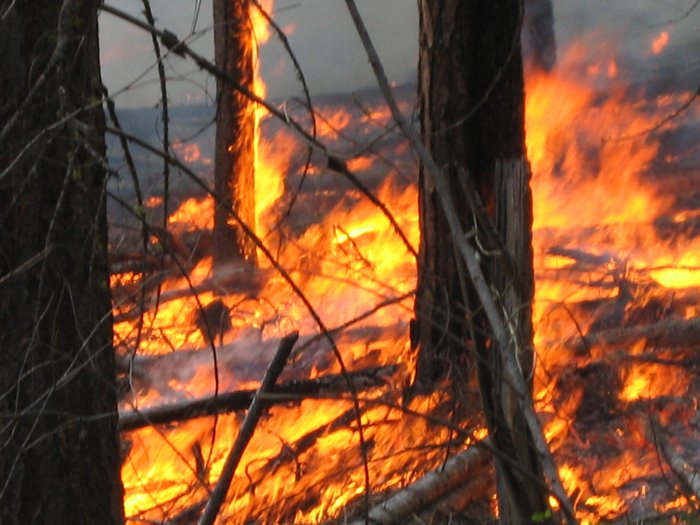
In contrast, “hot” fires tend to occur in hot, dry , and often windy conditions. They usually require large concentrations of receptive fuels and can be very fast-moving and transient (such as in tall grass) or slow-spreading and oven-like (in the case of heavy dead-and-down timber). In the boreal forest, warm summer temperatures and wind can combine to drive fire through closely spaced black spruce trees, creating a fast-moving hot fire that is primarily carried in the tree canopies, not on the ground.
Hot fires can dramatically change the character of forest, by killing off large swathes of forest. Very hot fires in heavy fuels can generate sufficient heat to sterilize tracts of land, via an extremely thorough burn-through (sometimes evocatively called “nuking” by firefighters). The intense heat kills most soil organisms, leaving characteristic ashy moonscapes, studded with the skeletons of dead trees.
The close spacing of black spruce trees makes intense “crown fires” frequent, where fire leaps directly from tree to tree. Although these fast-moving hot fires are not uncommon in spruce groves, they only rarely “nuke” the ground, since they moves quickly and burns mostly in the trees. Even when the tundra ground cover is destroyed, the underlying permafrost serves as a massive battery of cold and moisture, mitigating ground damage.
Likewise, fire in the lower-48 frequently burns through dead grass and light brush in technically hot, intense flaming front. The “residence time” of such fires, in both spruce trees and in grass, is low, meaning that the flame front passes very rapidly, and the area cools quickly. Grass fires may occur frequently, and are very dangerous to humans and animals, but the landscape recovers quickly. While the landscape left behind may appear totally denuded, soil life usually survives relatively unscathed. Crown fires also occur in timber in lower-48, frequently associated with steep terrain or strong winds. Although rare in occurence, these crown fires can occur in large timber and may be very destructive, due to the sheer amount of heat they liberate, however quickly they pass.
In contrast, intense fires burning through heavy dead-and-down timber act like ovens, moving slowly and cooking the surrounding area for hours. These fires can thoroughly kill soil life, leading to longer recovery times. In Alaska, extensive groves of beetle-killed trees are a prime example of a potential fuel soure for such fires. Dead trees killed by beetles can provide a huge mass of fuel, if the beetle-killed trees becoe dry enough. However, this threat is moderated by the fact that large logs often take several years of drought conditions to become dry enough to burn thoroughly, and the moist conditions in much of Alaska promote rot.
From a fire ecology perspective, both fast-moving crown fires and long-residence hot timber fires are expected to occur at those rare times when weather patterns, fuel concentratrion, and terrain come together to create extremely good burning conditions. However, high frequency and widespread hot fires in timber is not typical in most well-developed fire ecologies. In the black spruce, the reburn period for a given stretch of forest is actually quite long on the order of 50 to 250 years - meaning a given stretch of forest is expected to burn once every 50 to 250 years. In wet coastal rainforests, reburn period might be 1,000 years or more.
Fire scientists are concerned that a mix of changing climate, fuel accumulations (usually due to aggressive fire suppression), and infestations are leading to increasingly hot burns in many areas worldwide, including the boreal forest and the tundra. Frequent hot burns in such environments outpace the regenerative abilities of the biome, and lead to long-term changes in the environment. In the case of the boreal forest, this may include large-scale deforestation.
Climate Change & Fire
How Much of Alaska Burns?
According the National Interagency Fire Center, 1.3 million acres of Alaska burned in 2013 - about 30% of the total U.S. acreage scorched by wildfire, even though Alaska has only 18% of the country’s land area. This burning was done by only 603 out of the nation’s 47,579 separately identified wildfires. The 10-year average fire size in Alaska (~3,500 acres, 2004-2013) is 35 times as large as the average U.S. fire size for the same period.
However, Alaska has less fire suppression and less fire sensing. Fires often start in large clusters, caused by lightning strikes. Small fires can burn together before they are counted, or spontaneoulsy burn out before they are ever sensed. The resulting larger fires are counted individually - pushing average fire size up, and number of fires down.
Alaskan fire activity varies dramatically from year to year. In the last 10 years, Alaska’s burning as a percentage of total U.S. burning has swung between roughly 1% and 82% - and the absolute acreage has varied by a factor of 100, between 63,000 acres and 6.6 million acres. Nearly all of this fire occured within the boreal forest, which occupies 32% of Alaska’s land area.
There is considerable evidence to suggest that climate change is affecting Alaska’s wildfire regime. Research also indicates that prehistoric rapid climate changes had dramatic impacts on fire activity in North America.
Alaska’s climate-mediated boreal fire regime has been explored an example of a so-called “wicked problem.” Wicked problems are a class of complex and unpredictable challenges which can only be managed, not “solved”, and for which every management strategy creates new problems. In the case of fire in Alaska’s boreal forest, the problem is - concisely stated - how to manage and live with fire in the boreal forest, in conjunction with climate change, infestations, and other factors, with the knowledge that every management strategy leads to cascading repercussions. Further exploration is beyond the scope of this article, but can be read here.
Conclusion
Wildfire has a long history in Alaska’s ecology - as a rare agent in the temperate southern forests, and as a common force of ecological change and renewal in subarctic interior forests. As Alaska’s climate changes, the role of wildfire appears to be changing as well. As the arctic warms, permafrost thaws, and the boreal forest migrates, Alaska may be entering a fundamentally different burning regime. Events like the 2007 Anaktuvuk fire and the devastating 2010 Russian fire season may presage a new and destructive era of high-latitude fires. If new patterns are extreme enough, wildfire could help to fundamentally reshape the face of Alaska’s arctic and subarctic biomes.
However, ecological predictions of this scale must always be made with caution. Wildfire exists in dynamic equilibrium with many other natural phenomena, including insect infestations, weather patterns, living forest ecology, and human forestry.
Created: Jan. 19, 2018